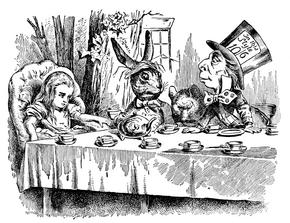Alice in Wonderland Plays upon Words and Numbers
Poetics, language, mathematics, and logic are all prevalent in Wonderland.
By Donna Iadipaolo

Lewis Carroll’s Alice in Wonderland is a book for children of all ages. However, reading the text as a child may be quite a different experience than reading it as an adult. For instance, one of the most amazing aspects of Alice in Wonderland is the relationship that Carroll crafts between language and mathematics. To bring some of these ideas out, a math teacher may wish to collaborate with an English teacher in order to to showcase the unique manner in which Carroll joins mathematics with language.
Multiple Multiplication Tables
Multiplication tables are a necessary skill for elementary students to master, yet, Alice seems to have forgotten them when she is agitated about her own identity. She believes if she can just remember her multiplication facts, she might be able to once again reclaim her identity: “Besides, she’s she, and I’m I, and--oh dear, how puzzling it all is! I’ll try if I know all the things I used to know. Let me see: four times five is twelve, and four times six is thirteen, and four times seven is--oh dear! I shall never get to twenty at that rate!” Most readers would know that 4 x 5 = 20, 4 x 6 = 24, 4 x 7 = 28 and instantly judge Alice for having forgotten her multiplication facts. They may even conclude that she is mad. But as American mathematician and writer Martin Gardner suggests, Alice created her own code, which can never reach the product of 20: 4 x 5 = 12, 4 x 6 = 13, and therefore 4 x 7, within her system, equals 14. Gardner also puts forth a theory of multiplying in various bases to achieve Alice’s products. It seems that Alice may not have really forgotten her childhood multiplication tables at all, but rather, she has begun a journey to a parallel universe of mathematics.
Prime Time Primes
In the Queen’s Croquet-Ground, Alice encounters three cards: two, five, and seven. The number of cards also important; Carroll has provided for his readers, after the number one, the next prime numbers: 2, 3, 5, and 7. Prime numbers, in Carroll’s time, were believed to possess inherent magical powers because they are irreducible. In fact, all numbers are either composites or primes. Notably, in 1859 (Wonderland was written in 1865), a German mathematician named Bernhard Reinman presented a paper to the Berlin Academy on the mystery of prime numbers. To this day, the wonder of prime numbers exists in mathematicians' continued pursuit to discover any possible pattern in the generation of prime numbers. Perhaps Carroll is inviting Alice, as well as his readers, to solve this mystery.
Two Negatives Equal a Positive
On another math topic, in the chapter titled “The Mock Turtle’s Story,” Carroll focuses on the concept of negative numbers. As a mathematician himself, Carroll would have been acutely aware that ancient cultures did not accept the concept of a negative number. As recently as the 1500s, many Western European mathematicians argued that negative numbers did not exist. The logic of the absence of a negative number was somewhat similar to “it’s impossible for anything to be less than nothing.” In Wonderland, Mock Turtle states there are to be 12 lessons that “lessen from day to day.” It is a clever play on the words lesson and lessen. So, Alice correctly answers that the “eleventh day must have been a holiday.” But there remains confusion about the twelfth day, because this would require a negative lesson. Is this, as Gardner suggests, when the student would begin teaching the teacher? May we only wonder how we would create a negative lesson? Or, would we spend hours unlearning material?
Here are some extension ideas for your study of Alice In Wonderland:
Literature Study Guide: Alice In Wonderland
Focusing on Alice in Wonderland by Lewis Carroll, this activity enables young readers to read, summarize, define vocabulary, and answer questions about the chapters they have read. The activity includes several literary activities to extend learning. It also includes several online resources for the novel, though the rest of the activities are not specific to the book.
With an eye toward algebra, pupils review the story of Alice in Wonderland and decipher the mathematics involved in the story by reading excerpts and deciphering it into if/then statements. There are 10 questions.
The Immigrant Experience: Down the Rabbit Hole
Young scholars relate the immigrant experience to Lewis Carroll's Alice's Adventures in Wonderland. In this immigration experience lesson, students read Lewis Carroll's Alice In Wonderland and relate it to the immigrant experience through class discussions. Young scholars also use primary sources to discuss the immigrant experience.
Learners imagine that they are casting directors for a student story-turned-movie. They must consider how they will make the book's characters as accurate, interesting, and fun as they are in the original work.